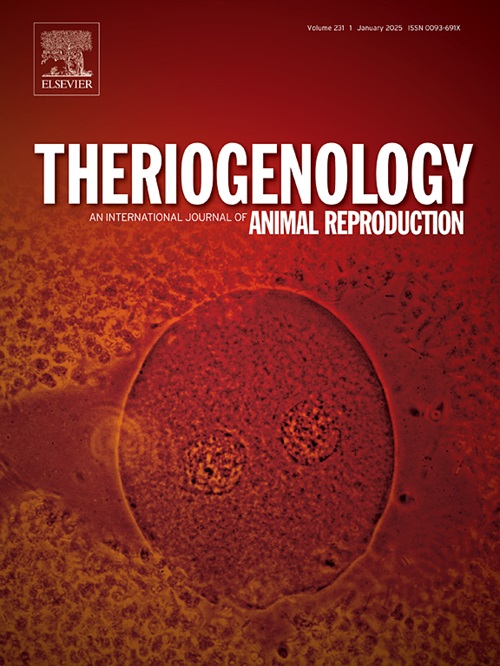纳米结构脂质载体包裹α-芒果苷的睾丸内给药临床试验:对猫科动物生殖健康的安全性和有效性。
IF 2.4
2区 农林科学
Q3 REPRODUCTIVE BIOLOGY
引用次数: 0
摘要
手术阉割是控制雄性动物生育能力的主要方法,但要大规模控制流浪动物的数量却不切实际。开发能诱导细胞凋亡而非坏死的纳米颗粒介导的绝育剂是一个复杂而有前景的研究领域。本研究旨在调查在168天的观察期内,睾丸内给药包裹在纳米结构脂质载体(AM-NLC)中的α-曼戈斯汀对睾丸变化的影响以及任何相关的不良反应。32 只健康的成年雄猫参加了研究。根据临床检查、血液分析和血清淀粉样蛋白 A 水平的评估,在整个研究期间,接受 AM-NLC(28 只)或空白 NLC(4 只)治疗的猫都没有出现与疼痛或压力有关的明显并发症。经 AM-NLC 治疗的猫的组织病理学分析表明,曲细精管上皮变性,导致曲细精管缺损。主要发现包括生殖细胞耗竭、精原细胞紊乱(某些区域无精子)、凋亡体和细胞质内空泡化。输卵管间质部没有炎症、透明化、纤维化或坏死的迹象。尽管发生了广泛的变性,但在病灶区域仍存在一些正常的小管。从第56天开始,曲细精管变性的严重程度评分明显增加(P 0.05)。总之,这项研究首次在雄性动物体内将凋亡诱导剂作为一种新型纳米药物抗生育化合物,用于非手术阉割。虽然事实证明 AM-NLC 制剂在睾丸内给药是安全的,但它未能诱发猫的不育症,因为附睾精子在整个研究过程中持续存在。进一步研究诱导细胞凋亡的替代纳米药物绝育剂仍然十分必要,也极具挑战性。本文章由计算机程序翻译,如有差异,请以英文原文为准。
Clinical trials of intratesticular administration of nanostructured lipid carriers encapsulated alpha-mangostin: Safety and efficacy on feline reproductive health
Surgical castration is a primary method for controlling male fertility, but it is impractical for large-scale population control of stray animals. Developing nanoparticle-mediated sterilants that induce cell apoptosis rather than necrosis is a complex and promising area of research. This study aimed to investigate the impact of intratesticular administration of alpha-mangostin encapsulated in nanostructured lipid carriers (AM-NLC) on testicular changes and any associated adverse effects over a 168-day observation period. Thirty-two healthy mature tomcats were enrolled. None of the cats treated with either AM-NLC (n = 28) or blank NLC (n = 4) exhibited noticeable complications related to pain or stress throughout the study, as assessed by clinical examination, blood profiles, and serum amyloid A levels. Histopathological analysis of AM-NLC treated cats revealed seminiferous epithelium degeneration, leading to defective tubules. Key findings included germ cell depletion, disorganized spermatogenic cells without spermatids in certain areas, apoptotic bodies, and intracytoplasmic vacuolization. The intertubular compartment showed no signs of inflammation, hyalinization, fibrosis, or necrosis. Despite widespread degeneration, some normal tubules were present in focal areas. The severity score of seminiferous tubule degeneration significantly increased from day 56 onwards (P < 0.05), suggesting a gradual and progressive compromise of the seminiferous epithelium. In contrast, testes from the blank-NLC group exhibited normal spermatogenesis. Overall, there were no significant changes in the volume of dissected testes, serum testosterone levels, or apoptotic index in AM-NLC-treated cats (P > 0.05). In conclusion, this study represents the first in vivo investigation of apoptotic-inducing agents as a novel nanomedicine-based antifertility compound for non-surgical castration in male animals. While the AM-NLC formulation proved safe for intratesticular administration, it failed to induce infertility in cats, as epididymal spermatozoa persisted throughout the study. Further research into alternative apoptosis-inducing nanomedicine sterilants remains both essential and challenging.
求助全文
通过发布文献求助,成功后即可免费获取论文全文。
去求助
来源期刊

Theriogenology
农林科学-生殖生物学
CiteScore
5.50
自引率
14.30%
发文量
387
审稿时长
72 days
期刊介绍:
Theriogenology provides an international forum for researchers, clinicians, and industry professionals in animal reproductive biology. This acclaimed journal publishes articles on a wide range of topics in reproductive and developmental biology, of domestic mammal, avian, and aquatic species as well as wild species which are the object of veterinary care in research or conservation programs.
 求助内容:
求助内容: 应助结果提醒方式:
应助结果提醒方式:


